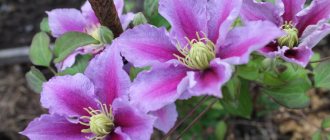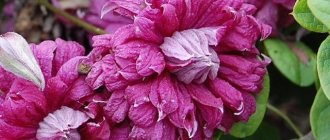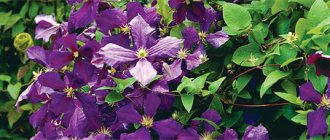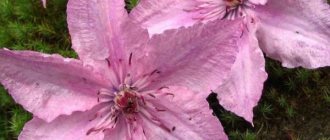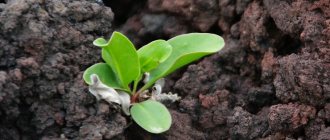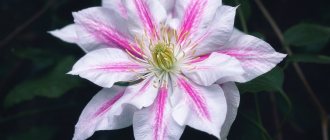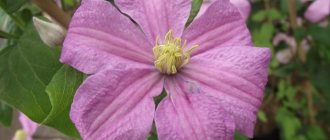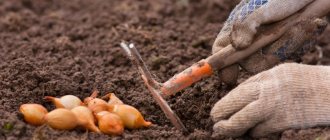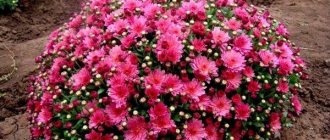Plants » Flowers
0
329
Article rating
Kira Stoletova
Clematis Taiga, bred by Japanese breeders, took part in the Plantarium 2021 flower exhibition and won silver. The new variety with multi-colored and complex-structured buds is unpretentious in cultivation and has an average degree of frost resistance. Let's consider the main characteristics of a perennial, as well as the rules for planting and caring for it.
Clematis taiga
Description of the clematis variety Taiga
Clematis Taiga is a perennial climbing plant of the Ranunculaceae family. The variety is characterized by fast growth rates and luxurious long-lasting flowering. The bush easily reaches a height of 2-2.5 m and a diameter of 1 m. Flexible and elastic vine-like shoots of clematis Taiga creep and are attached to the support with the help of tendrils and petioles. The leaves of the Taiga variety have smooth edges and can be elliptical, heart-shaped or trifoliate in shape. Foliage color is dark green.
Large, numerous buds of clematis variety Taiga open in several stages. Flowers can reach 12-15 cm. First, the outermost large petals, colored in lilac-violet, open. On each one you can see a complex watercolor pattern and interesting transitions from one shade to another. Next, the middle blooms, consisting of small petals of a more saturated purple-violet color with lemon tips, some of which are twisted into a tube. Last of all, the bright yellow core becomes noticeable. During the process of such metamorphoses, the color of the flower also changes, which makes the variety even more decorative. You can enjoy the lush double flowering of clematis Taiga from June to September.
Comment! Since 1994, all new varieties of clematis have been registered with the Royal Horticultural Society of Great Britain.
Clematis Taiga pruning group
According to the international classification, clematis are divided into 3 pruning groups depending on the nuances of laying new generative buds.
- Clematis without pruning. This group blooms in spring on last year's shoots and does not need pruning. In case of thickening and excessive growth, clematis of the 1st group are pruned after the end of flowering at a height of more than 1 m.
- Lightly pruned clematis. They bloom first on the shoots of last year in late spring - early summer, then after a short period they bloom on the shoots of the current year. Annual seedlings of this group are pruned completely at a height of 30 cm, and further pruning is carried out above 1.5 m.
- Hard pruned clematis. The 3rd group includes late-flowering, large-flowered, vigorously growing and herbaceous varieties. Depending on the type, they are pruned either above the 2-3rd bud, or at the base.
It is to the 3rd group that the clematis variety Taiga belongs. In the fall, the bush is subjected to radical pruning so that next year it will again grow numerous flowering shoots.
Origin and biological features
The place of this species in the classification is not clearly defined. Some experts consider it a subspecies of clematis straight, others identify it as a separate species included in the Flamula-Recta group, which combines varieties of herbaceous clematis with small fragrant flowers.
Abundantly flowering clematis covers vertical surfaces with a continuous carpet, but for this it is necessary to tie the stems to a support
The plant's homeland is Northeast China and the south of the Far East. Under natural conditions, it grows in well-lit places: along river banks, on forest edges and hillsides. Wild thickets of flowering clematis Manchurian in the photo look like delicate fluffy “clouds”, covering rocky slopes and enveloping the crowns of low trees with a continuous carpet.
The variety is a herbaceous vine up to 1.5 (less often up to 3) meters high. In nature, it behaves like a ground cover: the entire mass of growing stems simply “crawls” along the surface or lies on it in a dense “cap”. When using a plant in vertical gardening, its stems must be tied to a trellis. The leaves are small, complex, forming a beautiful openwork mass. The flowers are small (up to 2 cm in diameter), cross-shaped. They open completely and are usually directed upwards. They have a pleasant aroma that intensifies in direct sunlight. The petals are narrow, pointed, white. The anthers and stamens are light yellow. The seeds are numerous, small - “nuts” of light brown color.
The flowers and seeds of Clematis Manchurian are small, but plentiful and very decorative, giving the plant a special beauty and “airiness”
The flowering period takes from 2 to 6 weeks depending on climatic conditions. In the middle zone it occurs in July-August. The bushes bloom on the current year's stems. In this case, up to 400-500 flowers can form on each shoot. The plant is unpretentious and easily survives frosty winters and summer drought. In shaded areas it grows well, but hardly blooms. Like most clematis, it is not too demanding on the mineral composition of the soil, but is sensitive to soil acidity and does not tolerate stagnation of water in the root zone. Rarely gets sick. The most common insect pests are spider mites, as well as slugs and snails.
In the photo - clematis stinging - a tall shrubby vine, the stems of which become lignified
Winter hardiness of clematis Taiga
Clematis variety Taiga can be grown in frost hardiness zone 6 (USDA zone). This means that the minimum temperature during the cold season should not be below -23.3°C (-10°F). Lower temperatures will lead to inevitable freezing of this clematis variety. In warm winters, when it is -15°C or higher outside, clematis Taiga does not need to be covered. According to numerous reviews about the frost resistance of clematis Taiga, in the southern regions of the Russian Federation it winters well without shelter, in the middle zone - under a layer of mulch 10 cm thick.
Advantages and disadvantages of the variety
To properly grow a unique flower, you need to know about its advantages and disadvantages.
Advantages of Taiga:
- Due to the unique structure of the double inflorescence, clematis variety Taiga blooms throughout the summer.
- The compact size of the plant allows it to be grown even in small areas.
- The flower tolerates temperature changes and winter frosts well in temperate climates.
Among the disadvantages of the flower, it is worth noting its poor resistance to diseases and pests, and intolerance to heavily shaded areas.
Planting Clematis Taiga
Like any plant, clematis Taiga has its own life cycles, which must be taken into account when choosing a planting time. How abundantly and luxuriantly the crop of this variety will bloom depends on the quality of the planting material, the soil used, and the chosen location. Knowing the basic rules of agricultural technology and the preferences of clematis, you can easily grow picturesque green cascades strewn with numerous double flowers on your plot.
Landing dates
Clematis Taiga, like other varieties of this crop, is planted in open ground in mid-spring, when there is no danger of return frosts, or in the fall. Specific numbers depend on the climate of the region. When planting a Taiga seedling in spring, it should have several new shoots, and when planting in autumn, several vegetative buds.
Comment! In the south, autumn planting of clematis is preferred, while in the temperate zones, spring planting is preferred.
Preparing the landing site and soil
Clematis variety Taiga is a perennial plant, so the place for planting it must be chosen carefully so as not to replant the bush later and not to injure the root system. The area should be well lit by the sun throughout the day and protected from drafts. Piercing gusts of wind can break shoots and peduncles, causing clematis to lose its decorative appearance. Southern, eastern or western exposure is preferred.
Clematis variety Taiga does not tolerate shade. Planting near outbuildings, house walls or a solid fence is extremely undesirable; it can lead to the development of fungal diseases, rotting of the root system and even death of the plant. Clematis Taiga will grow slowly next to a solid support, and you can’t count on abundant flowering.
Attention! The minimum distance from the wall to the vine should be at least 30-50 cm.
Clematis variety Taiga prefers fertile, loose, well-drained soil. The pH reaction is neutral or slightly acidic. Moist loam is ideal for successfully growing clematis, while heavy clay soil will be detrimental to the root system. You should not plant the Taiga variety in an area with close groundwater.
Before planting clematis, carefully dig up the soil and add the following ingredients:
- humus - 2 buckets;
- coarse sand – 1 bucket;
- peat – 1 bucket;
- lime - 1 bucket;
- complex mineral fertilizer – 1.5 tbsp.;
- superphosphate – 0.5 tbsp;
- wood ash - 1 tbsp.
Preparation of planting material
When choosing planting material, it is better to choose seedlings with a closed root system; they are easier to transplant and adapt faster. If clematis are sold without containers, you need to carefully examine the root system - there must be at least 3 healthy roots 10 cm long.
Until the day of planting, seedlings are stored at a temperature of about 2°C. Immediately before starting work, containers with a lump of earth are soaked in settled water at room temperature for 10-30 minutes.
How to plant correctly
The algorithm for planting clematis Taiga is quite simple:
- In a place prepared in advance, they dig a hole with a diameter of 60 cm, the depth is also 60 cm.
- The distance between neighboring plants is 30 cm, between clematis of different varieties – 1.5-2 m.
- A drainage layer (crushed stone, stones, broken brick, sand, perlite) 10 cm thick is laid at the bottom of the pit, then a layer of fertile soil.
- A seedling is placed in the center of the hole, deepening it by 5-10 cm.
- The voids are filled with earth and lightly compacted.
- The planted clematis is watered abundantly, and the surface of the soil is covered with bark.
- It is better to shade the base of the bush by planting annual herbs nearby.
Growing the large-flowered variety Yulka
The agricultural technology of the variety is similar to other large-flowered clematis, but it also has its own nuances.
Conditions for good growth and flowering
Clematis Julka does not like extreme heat and open, too sunny places. It is better to plant it in partial shade, in a place protected from the winds.
You need soil with good moisture permeability; loam is perfect. On heavy soils with high acidity, the bush will struggle. The soil must be loose so that the roots receive enough oxygen. Clematis Julka does not like overheating of the soil around the roots, so in regions with hot summers, the soil near the bush must be covered with a thick layer of mulch and its moisture monitored.
Clematis Yulka loves moderately fertile loams
Throughout the growing season, Yulka needs abundant watering (but not too much so that the water does not stagnate in the ground). Feeding is required starting from the second year after planting:
- in spring - rotted manure (a bucket of slurry per bush) or mineral nitrogen fertilizer (15 g of ammonium nitrate per 10 liters of water);
- in the summer during the budding period - complex mineral fertilizer for clematis according to the instructions (for example, Agrecol, Actiwin) or ash;
- in the fall, before covering - superphosphate, ash (half a liter per bush) or bone meal (200 g per plant).
The Yulka variety is characterized by good frost resistance. According to the creators, it tolerates frosts from −6.7 to −34.4 °C. Its cultivation zones in our country are central Russia, including the Moscow region, the North-Western region (Leningrad region), the Far East (Vladivostok), Sochi.
Landing
To plant clematis Yulka you need to choose healthy seedlings. It is better to buy two-year-old plants - then there is a chance to quickly get a flowering bush. You can plant in early spring, in May, or in September-October - depending on the region.
Clematis seedlings. unlike many crops, you can buy and plant them already with leaves
Procedure:
- Dig a hole measuring 60x60 cm.
- Dig a support for the vine into the ground.
- Prepare drainage at the bottom with a layer of up to 20 cm.
- Make a hill of fertile soil on top.
- Place the seedling with the roots straightened and soaked in a root formation stimulator on a hill, placing the roots along the edges. If the seedling has a closed root system, simply place it on a hill. The root collar should be 10–15 cm below the ground level so that the plant begins to bush the next year.
- Fill the hole, forming a mound.
- Water the plant.
In the first year of life, the buds that appear must be cut off.
Video: planting clematis in autumn
The basis of care is pruning the bush
After the first frost, clematis Yulka begins to prepare for winter. All activities are carried out in dry weather.
This variety requires pruning of the second type (weak). Varieties of this group begin to bloom in late May - early June on last year's shoots, and then continue on this year's shoots. Only shoots of this year that have grown above 1.5 m are subject to pruning; the rest do not need to be touched.
Depending on the ability to form flower buds, clematis are pruned at different heights
First of all, the frozen tops are removed. The cut is made perpendicular to the shoot, leaving 10–15 tillering nodes (places where new buds and shoots develop).
Video: pruning clematis of different groups, including the second
Shelter for the winter
Before sheltering, you need to treat the vine against fungal diseases. To do this, prepare a 0.2% solution of Fundazol and water it on the soil around the roots at a distance of up to 0.5 m. It is better to mulch with a mixture of sand and ash (10 parts sand and one part ash) or humus. Do not use straw or grass clippings as mice may live in them.
The best type of shelter for any clematis, including the Yulka variety, is air-dry. They do it this way:
- The cut vine is carefully rolled into a circle.
- Place it on a prepared bedding of cut healthy shoots, spruce branches, dry branches or boards.
- Wrap with spunbond or lutrasil.
- Cover the top with spruce branches or dry leaves (undamaged by pests).
- Cover the entire structure with slate or plywood.
Caring for hybrid clematis Taiga
Agrotechnical measures for clematis variety Taiga are not much different from standard work in general for this crop. Timely moistening of the soil, fertilizing, loosening, tying, pruning, covering for the winter, prevention from pests and diseases - this is what a gardener will have to do when growing a Taiga plant.
Growing conditions
It would be optimal to plant the vine in a well-lit, windless place where water does not stagnate and the soil is loose and nutritious. Arches, gazebo walls, or a non-solid fence are suitable as supports. You should not plant perennials nearby, as they will interfere with the development of the clematis root system.
Watering mode
If there is no precipitation, clematis of the Taiga variety is watered 2-3 times a week, and 2-3 buckets are spent on one bush. Lack of moisture shortens flowering time and the size of flowers noticeably decreases. Watering must be done at sunset, when the summer heat gives way to evening coolness. Taiga responds well to regular irrigation with warm water. The bushes are sprayed either early in the morning or late in the evening every 2 days.
Important! Young plants need abundant watering more than others.
Fertilizing
The first year the Taiga vine is not fertilized - the soil contains enough nutrients added during planting. From the second year, the vines are fed in spring and autumn 1-2 times a month, alternating organic and mineral fertilizers. Fertilizers are also alternated according to the method of application:
- diluted and added when watering;
- scattered under a bush;
- spray the ground part.
Before flowering, the plant needs fertilizers with a high content of potassium and phosphorus. As soon as Taiga opens the buds, they stop feeding her. Before winter, apply potassium-containing fertilizers.
Warning! Fresh manure, mullein and chicken droppings should not be used to feed clematis.
Mulching and loosening
The soil under the bush is periodically loosened and weeded. This procedure is required if a dry crust has formed on the surface. Immediately after planting, a thin layer of pine bark, wood chips or pine litter is scattered at the base of the vine. This is necessary so that the soil at the roots does not overheat, since elevated soil temperatures are detrimental to the Taiga variety.
Tying up
Clematis variety Taiga is grown on wall or free-standing supports, as well as in spacious containers located on open terraces or balconies. In the lower part of the structure, the stems are tied with twine, then the tendrils are secured to the mesh, setting the direction of growth of the shoot; if necessary, individual lashes are fixed with twine or special staples.
Trimming and shaping
Clematis Taiga is a variety that requires heavy pruning. In the first year of the plant’s life, all shoots are cut off above strong buds at a distance of 30 cm from the ground, in the second year - 10 cm higher, in subsequent years the height of the ground part should be within 50 cm. Dry and damaged shoots are removed completely. The procedure is carried out in the fall.
To properly form a bush, it needs to be cut no higher than 30-50 cm, otherwise new shoots will form from buds located too high above the ground, and last year’s branches will remain bare.
Preparing for winter
When preparing clematis for winter, you should not only perform drastic pruning, but also cover it with a thick layer of mulch. Suitable covering materials:
- straw;
- spruce branches;
- dry leaves mixed with foam chips;
- bark.
In regions with a more severe climate than the temperate zone, a wooden container is placed above the bush, which is wrapped in film and sprinkled with earth. With the arrival of spring thaws, the shelter is removed.
Warning! It is not recommended to use sawdust as mulch; it accumulates moisture, which freezes when cold weather arrives, which can cause clematis to freeze.
Covering with sawdust for the winter also risks damping off due to excess humidity and overheating. It is important to remove the shelter in time; this largely determines how the plant will develop and bloom in the next season.
Planting and care
These are the two most important processes that you need to familiarize yourself with in more detail.
Landing
Having chosen the variety of clematis you like, you need to take care of planting it in the ground. This should be taken very seriously. The place should be sunny and protected from winds. After all, where there is a lot of shade, clematis will develop too slowly or may even die. In addition, you should not plant seedlings in lowlands, because cold air and moisture accumulate there, which have a bad effect on their development.
It is imperative to ensure that the soil is of good quality. Sandy and loamy soils, which are also well loosened, are suitable for planting. In the Siberian region, clematis grow for more than 10 years without replanting.
First you need to dig a hole. Its depth should be at least 65 centimeters, and its diameter should be up to 70 centimeters. At the very bottom it is necessary to lay out drainage from broken bricks. Its thickness should be no more than 15 centimeters.
After this, you need to add 20 kilograms of humus, 10 kilograms of peat, 10 kilograms of sand, 1 cup of ash, ½ cup of bone meal and ½ cup of superphosphate. Next, you need to install a support in the very center of the hole, and then fill it halfway with earth.
You need to place a seedling on top, straighten its roots well, and then sprinkle it with the remaining soil. If there is more than one seedling, then the distance between them should be no less than 1 meter. In this case, clematis will be able to receive the required amount of sun.
Care
In order for these beautiful plants to please everyone for as long as possible, it is necessary to provide them with proper care.
- Since all clematis are moisture-loving, watering must be done quite often. After all, they grow green mass very quickly and also form a large number of flowers. These plants need to be watered once every 7 days, but you also need to make sure that the soil is not too moist. In addition, you must remember that you need to water abundantly so that the entire root system of the clematis is moistened.
- After watering, the soil around the bush needs to be loosened well so that the moisture does not evaporate and there are not too many weeds.
- In addition, you need to mulch all the ground around the bush itself. You can use regular sawdust or even humus as mulch. In this case, the mulch after loosening will become an excellent top dressing.
- Since clematis grows so actively, it will require a lot of fertilizer. Therefore, fertilizing needs to be done regularly. Nitrogen fertilizing is best in early spring. When flowering begins, you will need potassium fertilizers; when clematis fades, you can use phosphorus fertilizers.
Diseases and pests
Clematis variety Taiga most often suffers from diseases of fungal origin, in particular Fusarium wilt. The development of the disease is associated with excess soil and air moisture. The best prevention against fungal infections is treating the soil with a solution of Fundazol (20 g/10 l). The procedure must be carried out 2 times a year - in spring and autumn.
The root system of clematis is often damaged by moles, shrews, nematodes, and mole crickets. The ground part may suffer from attacks by pests such as:
- aphid;
- spider mite;
- scale insect;
- slugs;
- snails
To repel pests, fertilizer containing ammonia is scattered under the bushes, or dill, parsley, marigolds, and calendula are planted. Affected plants should be immediately treated with appropriate medications. In the fight against aphids, spider mites, and scale insects, spraying with systemic insecticides helps; metaldehyde is used against slugs and snails.
Reproduction
The Taiga variety plant can be propagated independently in 3 ways. Each has its own positive and negative sides:
- Cuttings. Before flowering begins, branches are cut from an adult clematis bush, which are subsequently divided into cuttings 5-6 cm long, each with 2-3 nodes. The cuts are treated with “Kornevin”, the cuttings are planted in a sand-peat mixture so that the first node remains on the surface, and they are placed in a greenhouse until rooting. The undoubted advantage of this method is the production of a large number of plants at once.
- Layerings. A ditch about 10 cm deep is dug around the bush. Faded lashes are placed in the recesses, secured with wire and sprinkled with earth. Tops of 4-6 cm should remain on the surface. As the soil dries, the layering is watered. Next spring they are separated from the mother vine and transplanted to a permanent place.
- Dividing the bush. An adult clematis bush over 5 years old is dug up on one side. Using a sharp knife, a shoot with a rhizome is separated from it, which is immediately placed in a new place.
